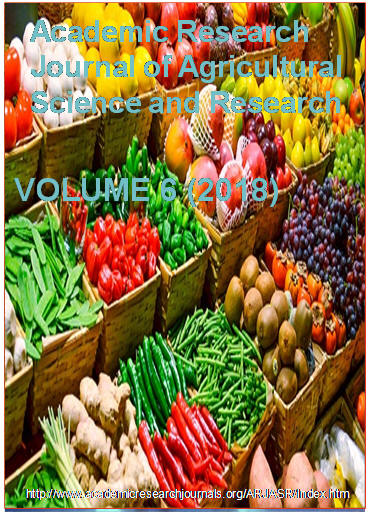| ARJASR |
Academic Research Journal of
Agricultural Science and Research |
|||||||||||||||||||
|
Vol. 6(9), pp. 539-546. December, 2018. ISSN: 2360-7874 DOI: 10.14662/ARJASRD2018.085 Full Length Research Performance of different Mulberry /Morus sp. / genotypes and their effect on mulberry silkworm, Bombyx mori (Lepidoptera: Bombycidae)
Metasebia Terefe1, Kedir Shifa1, Abiy Tilahun1, Ahmed Ibrahim1 Kassa Biratu2 and Afework Bogale3
1Melkassa Agricultural Research Center, P.O.Box-436, Adama Ethiopia 2Jimma Agricultural Research Center, P.O.Box-192, Jimma, Ethiopia 3 Hawassa Agricultural Research Center, P.O.Box-06 ,Hawassa, Ethiopia
Corresponding author: Metasebia Terefe, Ethiopian Institute of Agricultural Research Center, Melkassa Agricultural Research Center, Melkassa. E-mail: metasebiaterefe@gmail.com
Accepted 19 November 2018
Mulberry silkworms (Lepidoptera: Bombycidae) feed only on mulberry leaves and the performance of mulberry silkworms are influenced by mulberry varieties. The studies were conducted in field and laboratory conditions with the objectives to evaluate the agronomic and their rearing performance of different genotypes of mulberry on silkworms. In the present study, six different mulberry genotypes K-2, S-13, M-4, Nekemte, Jimma and Local check were evaluated in the field and laboratory for agronomic and their effect on mulberry silkworm (Bombyx mori). The treatments were arranged with Randomized Complete Block Design (RCBD) in the field and Completely Randomized Design (CRD) for laboratory experiments in three replications. Significant differences were observed in agronomic and rearing performances of mulberry silkworms. In field, maximum leaf production per plant (371.3 and 373.1), fresh leaf weight (26,503 and 26,333 kg/ha) and dry leaf weight (8027 and 8268 kg/ha) were recorded from S-13 and K-2, respectively. However, minimum fresh leaf weight (9435kg/ha) was recorded from Local genotype. Moreover, there were significant differences in rearing performance of silkworms fed on different genotypes of mulberry. Among different genotypes, silkworms fed on leaf of S-13 and K-2 gave better results such as cocoon weight (1.11g and 1.03g), pupal weight (0.924g and 0.864g), shell weight (0.187g and 0.168g), silk ratio (16.82% and 16.35%), as compared to other genotypes. In general, S-13 and K-2 showed better results in agronomic performances as well as in rearing performance of silkworms for improving silk production as compared to other genotypes. Thus, the result obtained by feeding of S-13 and K-2 genotypes of mulberry contributes for improving the rearing performance of mulberry silkworms. Therefore, these genotypes are recommended for further research and development works of Sericulture in the Country.
Key words: Mulberry genotypes, Agronomic, Mulberry Silkworm and Rearing Performance
How to cite this article (APA Style): Terefe, M., Shifa, K., Tilahun, A., Ibrahim, A., Biratu, K., Bogale, A. (2018). Performance of different Mulberry /Morus sp. / genotypes and their effect on mulberry silkworm, Bombyx mori (Lepidoptera: Bombycidae). Acad. Res. J. Agri. Sci. Res. 6(9): 539-546 |
|||||||||||||||||||
